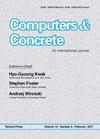适当正交分解降维在理解混凝土性能中的应用
IF 3.3
4区 工程技术
Q2 COMPUTER SCIENCE, INTERDISCIPLINARY APPLICATIONS
引用次数: 1
摘要
湿混凝土和凝结混凝土的性能受到一系列变量的影响。随着新配方的尝试和采用,了解这些配方的可加工性、强度和耐久性特征是至关重要的。在影响混凝土性能的众多变量中,识别最重要的变量,变量之间的相互作用,影响的量化,明智地操纵混合比例,放置,压实和养护,以获得期望的和有针对性的最终结果,可以通过采用最先进的数据处理工具大大改善。数据处理分组方法(GMDH)是一组数学算法,在多变量数据建模、优化和模式识别方面具有很大的应用潜力。适当正交分解(POD)是GMDH的一个子集,是一种系统降维和模式识别技术,在复杂数据集研究中具有重要意义。本文介绍了在混凝土技术中采用GMDH技术的必要性,并说明了这一方向的趋势,同时也说明了POD作为一种有效的决策工具,在高温下混凝土的降维和行为预测方面的效用。本文章由计算机程序翻译,如有差异,请以英文原文为准。
The utility of proper orthogonal decomposition for dimensionality reduction in understanding behavior of concrete
Properties of wet and set concrete are influenced by a wide range of variables. With new formulations being tried and adopted, understanding workability, strength and durability characteristics of these formulations is of utmost importance. From among the wide range of variables that affect properties of concrete, identification of the most vital, interplay between variables, quantification of influence, for judicious manipulation of mix proportioning, placement, compaction and curing, to get the desired and targeted end results can vastly be improved by employing the state of the art data handling tools. Group method of data handling (GMDH), a set of mathematical algorithms, is of great usage potential in multi-variable data modeling, optimization and pattern recognition. Proper Orthogonal Decomposition (POD) a subset of GMDH, a technique for systematic dimensionality reduction and pattern recognition, is of great importance in studying complex datasets. This paper presents the need for adoption of GMDH techniques in concrete technology with an account of trends in this direction and also provides an illustration of POD's utility as a valid decision-making tool in dimensionality reduction and projection of behavior of concrete subjected to elevated temperature.
求助全文
通过发布文献求助,成功后即可免费获取论文全文。
去求助
来源期刊

Computers and Concrete
工程技术-材料科学:表征与测试
CiteScore
8.60
自引率
7.30%
发文量
0
审稿时长
13.5 months
期刊介绍:
Computers and Concrete is An International Journal that focuses on the computer applications in be considered suitable for publication in the journal.
The journal covers the topics related to computational mechanics of concrete and modeling of concrete structures including
plasticity
fracture mechanics
creep
thermo-mechanics
dynamic effects
reliability and safety concepts
automated design procedures
stochastic mechanics
performance under extreme conditions.
 求助内容:
求助内容: 应助结果提醒方式:
应助结果提醒方式:


